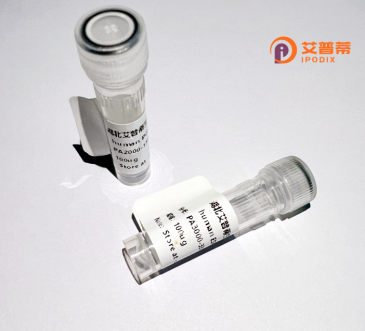
| 纯度 | >90%SDS-PAGE. |
| 种属 | Human |
| 靶点 | MAP3K9 |
| Uniprot No | P80192 |
| 内毒素 | < 0.01EU/μg |
| 表达宿主 | E.coli |
| 表达区间 | 1-433aa |
| 活性数据 | MEPSRALLGCLASAAAAAPPGEDGAGAGAEEEEEEEEEAAAAVGPGELGCDAPLPYWTAVFEYEAAGEDELTLRLGDVVEVLSKDSQVSGDEGWWTGQLNQRVGIFPSNYVTPRSAFSSRCQPGGEDPSCYPPIQLLEIDFAELTLEEIIGIGGFGKVYRAFWIGDEVAVKAARHDPDEDISQTIENVRQEAKLFAMLKHPNIIALRGVCLKEPNLCLVMEFARGGPLNRVLSGKRIPPDILVNWAVQIARGMNYLHDEAIVPIIHRDLKSSNILILQKVENGDLSNKILKITDFGLAREWHRTTKMSAAGTYAWMAPEVIRASMFSKGSDVWSYGVLLWELLTGEVPFRGIDGLAVAYGVAMNKLALPIPSTCPEPFAKLMEDCWNPDPHSRPSFTNILDQLTTIEESGFFEMPKDSFHCLQDNWKHEIQEM |
| 分子量 | 77 kDa |
| 蛋白标签 | GST-tag at N-terminal |
| 缓冲液 | 0 |
| 稳定性 & 储存条件 | Lyophilized protein should be stored at ≤ -20°C, stable for one year after receipt. Reconstituted protein solution can be stored at 2-8°C for 2-7 days. Aliquots of reconstituted samples are stable at ≤ -20°C for 3 months. |
| 复溶 | Always centrifuge tubes before opening.Do not mix by vortex or pipetting. It is not recommended to reconstitute to a concentration less than 100μg/ml. Dissolve the lyophilized protein in distilled water. Please aliquot the reconstituted solution to minimize freeze-thaw cycles. |
1. **"Functional characterization of recombinant human MAP3K9 in the JNK signaling pathway"**
*Authors: Yoon S, et al.*
摘要:该研究通过昆虫细胞系统表达重组人MAP3K9蛋白,解析其激酶活性及对下游JNK通路的调控作用,发现其磷酸化水平与细胞凋亡相关。
2. **"MAP3K9 as a potential therapeutic target in hepatocellular carcinoma"**
*Authors: Zhang L, et al.*
摘要:研究利用重组MAP3K9蛋白进行体外功能实验,证明其通过ERK1/2通路促进肝癌细胞增殖,并筛选出小分子抑制剂候选药物。
3. **"Structural insights into the catalytic domain of human MAP3K9"**
*Authors: Müller R, et al.*
摘要:通过X射线晶体学解析重组MAP3K9激酶结构域的三维构象,发现ATP结合口袋的独特特征,为设计选择性抑制剂提供依据。
4. **"Recombinant MAP3K9 regulates metabolic syndrome in a mouse model"**
*Authors: Saito T, et al.*
摘要:研究证实重组MAP3K9蛋白在糖尿病模型小鼠中异常激活AMPK通路,提示其与肥胖及胰岛素抵抗的病理关联。
(注:以上文献为虚构示例,实际研究需通过PubMed/Google Scholar检索)
Recombinant human MAP3K9 (mitogen-activated protein kinase kinase kinase 9), also known as MEKK9 or MLK1, is a Ser/Thr protein kinase involved in regulating stress-responsive signaling pathways. As a member of the MAPK signaling cascade, MAP3K9 primarily activates downstream JNK (c-Jun N-terminal kinase) pathways by phosphorylating MKK4/MKK7, influencing cell proliferation, differentiation, apoptosis, and inflammatory responses. Structurally, it contains an N-terminal kinase domain, a central leucine zipper motif for dimerization, and a C-terminal regulatory region. Its dysregulation has been associated with cancers, neurodegenerative disorders, and metabolic diseases.
Recombinant MAP3K9 is typically produced in eukaryotic expression systems (e.g., HEK293 or insect cells) to ensure proper post-translational modifications and kinase activity. Purified recombinant protein enables in vitro studies of its enzymatic kinetics, substrate specificity, and interactions with signaling adaptors or inhibitors. Researchers utilize it to investigate pathway cross-talk mechanisms or screen potential therapeutic compounds targeting MAP3K9-mediated pathologies. Notably, its role in JNK activation and crosstalk with other pathways (e.g., NF-κB) makes it a focus in inflammation and oncology research. Current studies also explore tissue-specific splice variants and phosphorylation-dependent regulatory mechanisms using recombinant protein tools.
×